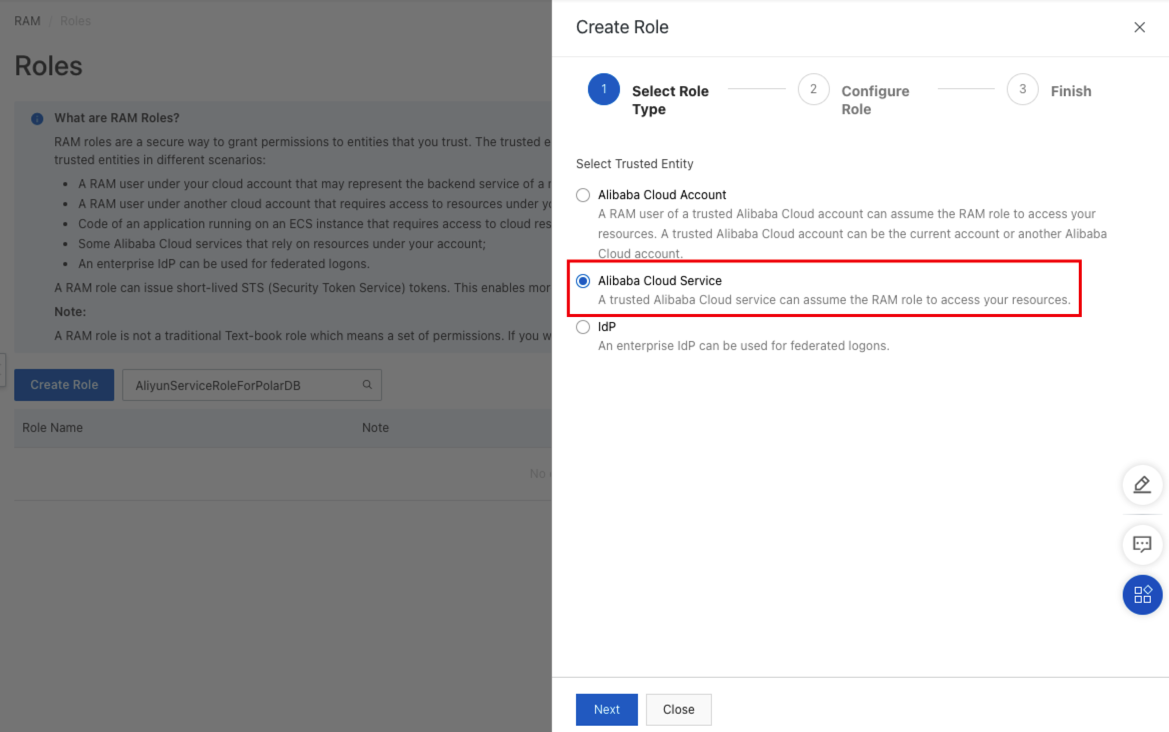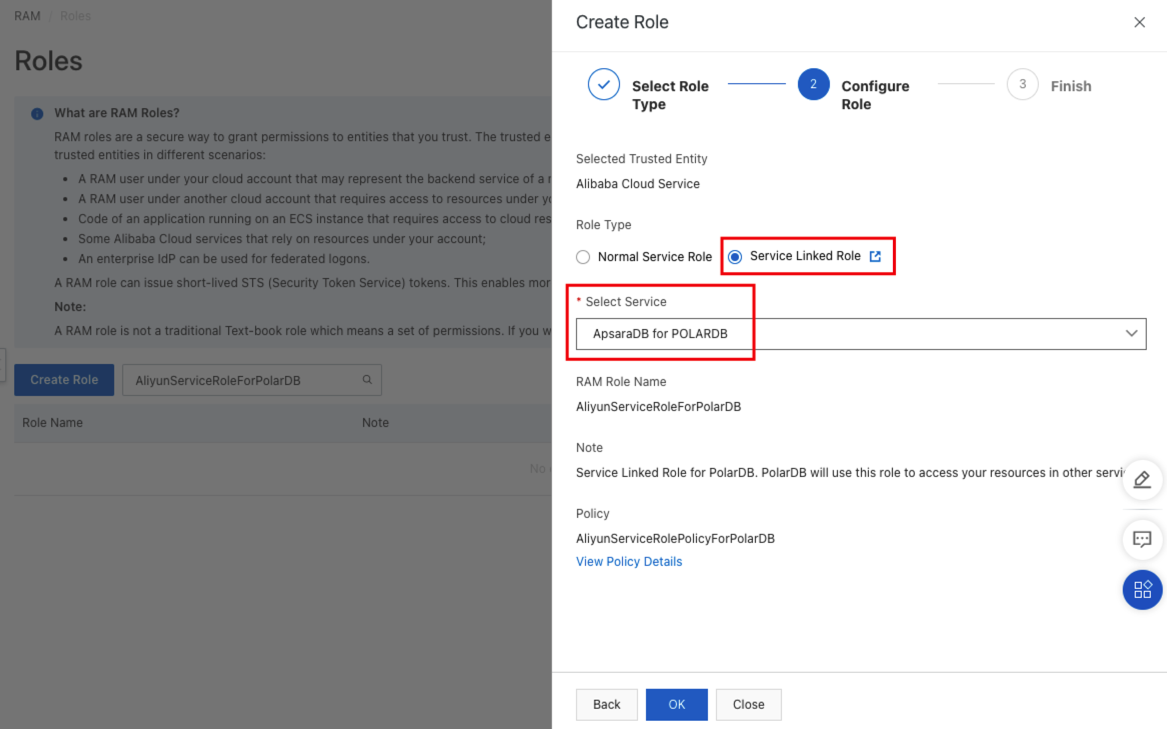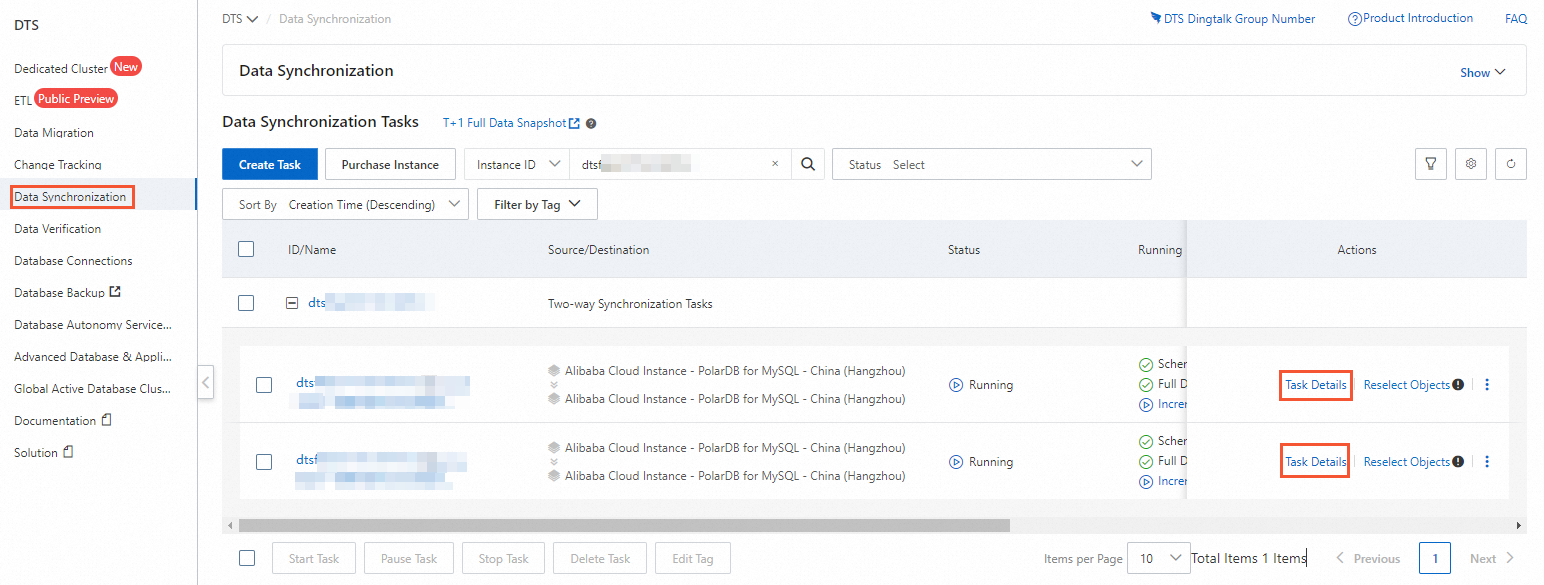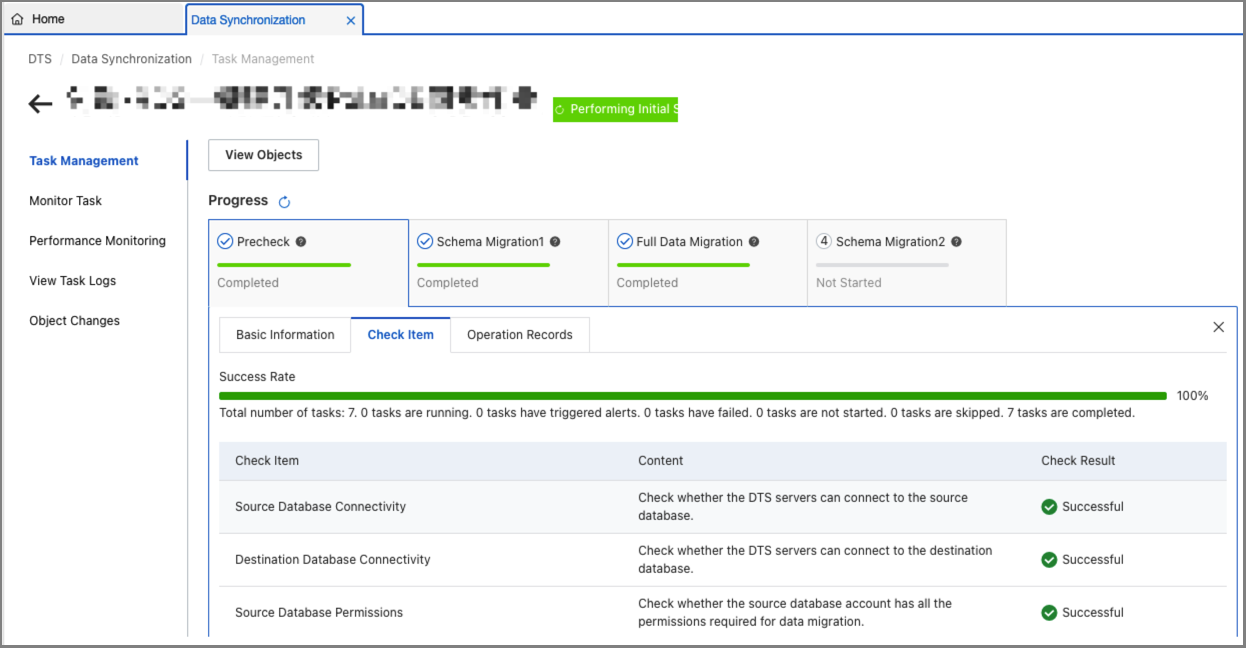This topic describes the procedure to clone an ApsaraDB RDS for MySQL instance to a PolarDB for MySQL cluster with one click, the two cloning methods and their comparisons, benefits, prerequisites, limits, and billing rules.
Precautions
If you migrate data to a PolarDB cluster by using one-click cloning, the incremental data of the source ApsaraDB RDS for MySQL instance is not synchronized to the PolarDB cluster.
For more information about how to synchronize incremental data from the source ApsaraDB RDS for MySQL instance to the PolarDB cluster when you create a PolarDB cluster, see Create a PolarDB for MySQL cluster by upgrading an ApsaraDB RDS for MySQL instance.
Background information
PolarDB allows you to clone data from an ApsaraDB RDS for MySQL instance to a PolarDB for MySQL cluster. You can use the one-click cloning method to create a PolarDB cluster that has the same data as the source ApsaraDB RDS instance. The PolarDB cluster retains the accounts, databases, IP whitelists, and required parameters of the source ApsaraDB RDS instance.
Source ApsaraDB RDS for MySQL instances and destination PolarDB for MySQL clusters must meet the following requirements:
Source ApsaraDB RDS for MySQL instances that run all MySQL versions and that use all storage types can be cloned. You can clone instances that run MySQL 5.6, 5.7, and 8.0 and that use local SSDs and cloud disks to PolarDB for MySQL clusters with one click.
ApsaraDB RDS for MySQL instances can be clone to PolarDB for MySQL clusters that run the same or different MySQL versions with one click. For example, you can clone an ApsaraDB RDS for MySQL 5.6 instance to a PolarDB for MySQL 5.6 cluster, or to a PolarDB for MySQL 8.0 cluster.
The logical migration method is used in the following scenarios: cloning an ApsaraDB RDS for MySQL 8.0 instance, cloning an ApsaraDB RDS for MySQL instance with cloud disks to a PolarDB for MySQL cluster, and cloning an ApsaraDB RDS for MySQL instance to a PolarDB for MySQL cluster that runs a different MySQL version. This method is implemented based on the data synchronization capability of Data Transmission Service (DTS).
Comparison between physical migration and logical migration
The one-click cloning feature supports physical migration (physical replication) and logical migration (data synchronization over DTS).
Physical migration: You can use the physical replication method to copy full data from the source ApsaraDB RDS for MySQL instance to the destination PolarDB for MySQL cluster.
Logical migration: You can create a data synchronization task on DTS to migrate the schemas and full data of the source ApsaraDB RDS for MySQL instance to the destination PolarDB for MySQL cluster.
The following table compares the physical migration and logical migration methods.
Billing method | Physical migration | Logical migration |
Whether DTS is required | No. | Yes. |
Whether incremental data migration or synchronization is supported | No. | No. |
Whether operations on the source ApsaraDB RDS for MySQL instance are affected | No. | No. |
Whether the source and destination can run different MySQL versions | Only source instances that run MySQL 5.6 and 5.7 and that use local disks can be cloned to destination clusters that run the same MySQL version. | The MySQL versions can be the same or different between the source and destination. |
Whether new database accounts must be created in PolarDB clusters after the cloning | No. After the cloning, the destination PolarDB cluster contains the accounts of the source instance. | No. After the cloning, the destination PolarDB cluster contains the accounts of the source instance. |
Whether new databases can be migrated | No. | No. |
The following table describes the MySQL versions and storage types supported by the two migration methods.
MySQL version | RDS Basic Edition | RDS High-availability Edition | RDS Cluster Edition | Enterprise Edition |
5.6 | N/A | Local SSD | N/A | Local SSD |
5.7 | Cloud disk | Local SSD and cloud disk | Cloud disk | Local SSD |
8.0 | Cloud disk | Local SSD and cloud disk | Cloud disk | Local SSD |
Physical migration is used only for cloning an ApsaraDB RDS for MySQL 5.6 or 5.7 instance of High-availability Edition that uses local SSDs to a PolarDB for MySQL cluster of the same MySQL version. Logical migration is used for cloning an ApsaraDB RDS for MySQL instance of other specifications to a PolarDB for MySQL cluster of the same or different versions.
Benefits
The cloning feature is free of charge.
No data loss occurs during the cloning process.
Prerequisites
When physical migration is used, the source ApsaraDB RDS instance must meet the following requirements. Logical migration is not subject to these requirements.
For ApsaraDB RDS for MySQL 5.6, the minor version of the instance must be 20190815 or later.
For ApsaraDB RDS for MySQL 5.7, the minor version of the instance must be 20200331 or later.
NoteYou can execute the
SHOW VARIABLES LIKE '%rds_release_date%';statement to view the minor version of the source ApsaraDB RDS instance. If the minor version is earlier than the required version, you can clone the minor version to the latest version. For more information, see Update the minor engine version.The table storage engine for the source RDS instance must be InnoDB or X-Engine.
Transparent Data Encryption (TDE) and SSL are disabled on the source ApsaraDB RDS for MySQL instance. For more information, see TDE and SSL. If TDE or SSL is enabled, you can manually create a data synchronization task on DTS to migrate the source instance to the destination PolarDB cluster. For more information, see Migrate data from an ApsaraDB RDS for MySQL instance to a PolarDB for MySQL cluster.
If Database Proxy (Safe Mode) is enabled for the ApsaraDB RDS for MySQL instance, a privileged account is created or the network connection mode of the ApsaraDB RDS for MySQL instance is switched to high-performance mode. For more information, see Create an account and [Product changes/Feature changes] The network connection mode of an ApsaraDB RDS instance is upgraded.

Limits
You can upgrade an ApsaraDB RDS for MySQL instance only to a PolarDB for MySQL cluster of the same or a later MySQL version, but not to a cluster of an earlier MySQL version.
For example, you cannot upgrade an ApsaraDB RDS for MySQL 5.7 instance to a PolarDB for MySQL 5.6 cluster, or upgrade an ApsaraDB RDS for MySQL 8.0.2 instance to a PolarDB for MySQL 8.0.1 cluster.
The physical migration method is subject to the following limits:
Cross-region data migration is not supported.
You cannot set the parameters of the source ApsaraDB RDS for MySQL instance during data migration.
The logical migration method is subject to the following limits:
Cross-region data migration is not supported.
You cannot set the parameters of the source ApsaraDB RDS for MySQL instance during data migration.
Source ApsaraDB RDS for MySQL instances are subject to the limits listed in the following table.
Item
Description
Limits on the source instance
The tables to be synchronized must have PRIMARY KEY or UNIQUE constraints and all fields must be unique. Otherwise, the destination database may contain duplicate data records.
If you select tables as the objects to be synchronized and you need to edit tables (such as renaming tables or columns) in the destination database, up to 1,000 tables can be synchronized in a single data synchronization task. If you run a task to synchronize more than 1,000 tables, a request error occurs. In this case, we recommend that you configure multiple tasks to synchronize the tables in batches or configure a task to synchronize the entire database.
Binary logging: The binary logging feature must be enabled. For more information about how to enable binary logging, see Modify instance parameters. In addition, the binlog_row_image parameter must be set to full. Otherwise, error messages are returned during precheck, and the data synchronization task cannot be started.
The following limits also apply:
Item
Description
Other limits
Before you synchronize data, evaluate the impact of data synchronization on the performance of the source and destination databases. We recommend that you synchronize data during off-peak hours. During initial full data synchronization, DTS uses read and write resources of the source and destination databases. This may increase the loads on the database servers.
During full data synchronization, concurrent INSERT operations cause fragmentation in the tables of the destination database. After full data synchronization is complete, the tablespace of the destination database is larger than that of the source database.
If you select one or more tables instead of an entire database as the objects to synchronize, do not use gh-ost or pt-online-schema-change to perform DDL operations on the tables during data synchronization. Otherwise, data may fail to be synchronized.
If you use only DTS to write data to the destination database, you can use Data Management (DMS) to perform online DDL operations on source tables during data synchronization. For more information, see Change schemas without locking tables.
During data synchronization, we recommend that you use only DTS to write data to the destination. This prevents data inconsistency between the source and destination. For example, if you use tools other than DTS to write data to the destination, data loss may occur in the destination when you use DMS to perform online DDL operations.
By default, DTS disables FOREIGN KEY constraints for the destination database in a data synchronization task. Therefore, the cascade and delete operations of the source database are not synchronized to the destination database.
Billing rules
The following billing rules are applicable to the physical migration method:
You are not charged for data migration from the source ApsaraDB RDS for MySQL instance to the PolarDB cluster. You are charged only for purchasing the PolarDB cluster. For more information, see Billable items overview.
The following billing rules are applicable to the logical migration method:
You are charged for both purchasing PolarDB clusters and creating data synchronization tasks on DTS. However, the upgrade feature is in the free-trial phase. No fees are charged for a synchronization task within 30 days after it is created. The following table describes the billing rules for the logical migration method.
Migration object
Billing rule
Schema synchronization and full data synchronization
No fees are charged for a synchronization task within 30 days after it is created.
After more than 30 days, the synchronization task will be canceled.
NoteYou can go to the Data Synchronization page of the new DTS console to view the remaining time of the synchronization task.
The following sections describe the procedure to clone an ApsaraDB RDS for MySQL instance to a PolarDB for MySQL cluster.
Precheck whether the service-linked role for PolarDB is created (only for logical migration)
Before you use the logical migration (data synchronization over DTS) method to perform a one-click cloning, check whether the service-linked role for PolarDB has been created for the current Alibaba Cloud account. Perform the following steps:
Log on to the RAM Console.
In the left-side navigation pane, choose Identities > Roles.
Check whether a service-linked role named AliyunServiceRoleForPolarDB already exists in the list, as shown in the following figure.
If the service-linked role exists in the list, skip this section and perform the operations described in Step 1: Migrate data from the source ApsaraDB RDS for MySQL instance.
If the service-linked role does not exist in the list, continue with the following steps.
In the upper-left corner, click Create Role.
In the Select Role Type step of the Create Role panel, select Alibaba Cloud Service and click Next.

In the Configure Role step, set Role Type to Service Linked Role and select ApsaraDB for POLARDB from the Select Service drop-down list.

Click OK. In the role list, confirm that the role is created.
Precheck whether redundant system accounts are removed from the source ApsaraDB for RDS instance
To ensure compatibility between ApsaraDB RDS for MySQL and PolarDB in terms of the system account structure and to prevent the system accounts of the destination PolarDB cluster from being overwritten during migration, make sure that the root and aliyun_root accounts do not exist in the source ApsaraDB for RDS instance at the same time. Before you initiate the migration process, we recommend that you remove redundant system accounts from the source ApsaraDB for RDS instance.
The following table lists the correct system account name for each version of ApsaraDB RDS for MySQL.
MySQL version | Correct system account name |
RDS MySQL 5.6 | root |
RDS MySQL 5.7 | aliyun_root |
RDS MySQL 8.0 | aliyun_root |
Apart from the corresponding system account for each version mentioned in the preceding table, all other system accounts must be removed.
These accounts can be either created by users or automatically created by the system during version upgrades. Specific accounts may not be visible in the console in certain scenarios.
The following example shows how to remove redundant system accounts from an ApsaraDB RDS for MySQL 5.6 instance:
Use a privileged account to connect to the instance.
Find all root and aliyun_root system accounts.
select * from mysql.user where user in ('root', 'aliyun_root');Remove redundant system accounts. The correct system account name of ApsaraDB RDS for MySQL 5.6 is root. Therefore, you must remove the aliyun_root account.
delete from mysql.user where user = 'aliyun_root' limit n;
Step 1: Migrate data from the source ApsaraDB RDS for MySQL instance
In this step, a PolarDB cluster is created. The cluster stores the same data as the source ApsaraDB RDS for MySQL instance.
Log on to the PolarDB console.
In the top navigation bar, select the region in which the cluster that you want to manage is deployed.
Click Create Cluster.
Set Billing Method to Subscription or Pay-As-You-Go.
Subscription: When you create a cluster, you must pay for the compute nodes. You are charged for the use of storage resources and the costs are deducted from your account balance on an hourly basis.
Pay-As-You-Go: An upfront payment is not required. You are charged fees for the compute nodes and the storage that is consumed by your data. The fees are deducted from your account balance on an hourly basis.
NoteRefer to Overview to learn about the comparison between the subscription and pay-as-you-go billing methods, and select a product type that is suitable for your business scenarios.
Configure the following parameters.
NoteFor more information about the parameters that are not described in the following table, see Purchase a pay-as-you-go cluster or Purchase a subscription cluster.
Parameter
Description
Creation Method
Select Clone from RDS.
Region
The region where the source ApsaraDB RDS for MySQL instance is deployed.
NoteThe destination PolarDB cluster must be also deployed in this region.
Source RDS Version
The engine version of the source RDS instance. You can select 5.6, 5.7, or 8.0.
Source RDS Instance
The source ApsaraDB RDS for MySQL instance. The available source ApsaraDB RDS for MySQL instances exclude read-only instances.
Database Engine
The database engine version of the destination PolarDB cluster. You can select the same version as the source ApsaraDB RDS for MySQL instance or a different version.
Node Specification
The node specifications of the cluster. You can specify node specifications based on your business requirements. We recommend that you select specifications that are the same as or higher than the specifications of the source ApsaraDB RDS for MySQL instance. For more information about PolarDB node specifications, see Compute node specifications of PolarDB for MySQL Enterprise Edition.
After you complete the basic settings, click Next: Cluster Configurations. Configure the following parameters.
Parameter
Description
Cluster Name
Select Auto-generate or Custom cluster name.
If you select Auto-generate, the system automatically generates a cluster name after the cluster is created. You can modify the automatically generated cluster name.
If you select Custom, you must enter a cluster name.
The name cannot start with
http://orhttps://.The name must be 2 to 256 characters in length.
The name must start with a letter and can contain letters, digits, periods (.), underscores (_), and hyphens (-).
Resource Group
Select a resource group from the drop-down list. For more information, see Create a resource group.
Network Type
The network type is fixed as VPC. You do not need to configure this parameter. Configure the VPC and vSwitch.
If an existing VPC meets your network requirements, select the VPC. For example, if you have an existing ECS instance and the VPC to which the ECS instance belongs meets your network requirements, select this VPC.
Otherwise, use the default VPC and the default vSwitch.
Default VPC:
Only one VPC is specified as the default VPC in the region that you select.
The CIDR block of the default VPC uses a 16-bit subnet mask. For example, the CIDR block of the default VPC can be 192.168.0.0/16. This CIDR block provides up to 65,536 private IP addresses.
The default VPC does not count towards the quota of VPCs that you can create on Alibaba Cloud.
Default vSwitch:
Only one vSwitch is specified as the default vSwitch in the zone that you select.
The CIDR block of the default vSwitch uses a 20-bit subnet mask. For example, the CIDR block of the default vSwitch can be 192.168.0.0/20. This CIDR block provides up to 4,096 private IP addresses.
The default vSwitch does not count towards the quota of vSwitches that you can create in a VPC.
If the default VPC and vSwitch cannot meet your requirements, you can create your own VPC and vSwitch. For more information, see Create and manage a VPC.
Enable Binary Logging
Set Enable Binary Logging. For more information about binary logging, see Enable binary logging.
Release Cluster
Set the backup retention policy when the cluster is released.
Retain Last Automatic Backup (Automatic Backup before Release) (Default): The system retains the last backup when you delete the cluster.
Retain All Backups: The system retains all backups when you delete the cluster.
Delete All Backups (Cannot be Restored): The system retains no backups when you delete the cluster.
Click Next: Confirm Order.
Check the cluster configurations, and set Duration, Quantity, and whether to Auto-renewal for subscription clusters. The Duration and Auto-renewal parameters are valid only for subscription clusters.
Read and select Terms of Service. Click Buy Now.
On the Purchase page, confirm the order and the payment method, and click Purchase.
NoteAfter you complete the payment, wait for 10 to 15 minutes. Then, you can view the new cluster on the Clusters page.
If specific nodes in the cluster are in the Creating state, the cluster is still being created and is unavailable. The cluster is only available when the cluster is in the Running state.
Make sure that you select the region where the cluster is deployed. Otherwise, you cannot view the cluster.
Log on to the PolarDB console and check the status of the new PolarDB cluster.
NoteIf the logical migration method is used, click the cluster ID to go to the Basic Information page and view the migration status. If the Status field in the RDS Migration section is Precheck Failed, follow the instructions in the error message to troubleshoot the issue.

For example, if a trigger is created in the source ApsaraDB RDS for MySQL instance, the precheck fails and the "The RDS instance has a trigger." error message is reported. You can delete the trigger and then click Continue. Alternatively, you can click Cancel and then manually create a data synchronization task in the DTS console. For more information, see Configure a data synchronization task for a source database that contains a trigger.
You can also click Cancel to cancel the migration task. For more information, see FAQ.
Step 2: View the details of a data synchronization task (for logical migration only)
If the logical migration method is used, click the cluster ID to go to the Basic Information page and view the migration status. If migration errors (such as a precheck failure) or other exceptions (such as very high replication latency) occur, you can go to the details page of the data synchronization task to view the details.
Log on to the PolarDB console.
Find the cluster and click its ID.
In the RDS Migration section of the Basic Information page, click the name of DTS Data Synchronization Task to go to the data synchronization task list in the DTS console.

Find the data synchronization task. You can view precheck failure details, data synchronization task details, and data synchronization task logs.


FAQ
What are the differences between upgrading an ApsaraDB RDS for MySQL instance to a PolarDB for MySQL cluster and cloning an ApsaraDB RDS for MySQL instance to a PolarDB for MySQL cluster?
The following table describes the differences.
Billing method
Upgrading an ApsaraDB RDS for MySQL instance to a PolarDB for MySQL cluster
Cloning an ApsaraDB RDS for MySQL instance to a PolarDB for MySQL cluster
Whether incremental data migration or synchronization is supported
Yes
No
Whether operations on the source ApsaraDB RDS for MySQL instance are affected
No
No
Whether the source and destination can run different MySQL versions
Yes
Yes
Is the source ApsaraDB RDS for MySQL instance affected when data is cloned from the ApsaraDB RDS for MySQL instance?
No, the source ApsaraDB RDS for MySQL instance is not affected when data is migrated from the ApsaraDB RDS for MySQL instance.
What happens if I cancel the migration?
If you cancel the migration, the following situations occur:
The synchronization link from the source cluster to the destination cluster is disconnected. The source cluster is no longer associated with the destination cluster.
The destination cluster becomes readable and writable and is not automatically released. If you no longer use the cluster, release it at the earliest opportunity to prevent additional costs.
If you manually cancel the migration, you can specify whether to disable the binary logging feature for the cluster. Binary logging is not disabled if the migration is automatically canceled.
NoteIf the binary logging feature is disabled for the cluster, the write performance of the cluster is slightly improved. After the binary logging feature is disabled, existing binary logs are retained. To delete the binary logs, you can enable the feature and specify a short retention period. After the retention period is reached, binary logs are automatically deleted. Then, you can disable the binary logging feature. After the binary logging feature is disabled, the cluster is automatically restarted. The restart task is completed within 5 minutes. The service interruption lasts approximately 40 seconds during the restart. The length of recovery time varies based on the data volume and the number of tables. We recommend that you perform this operation during off-peak hours and make sure that your application is configured to automatically reconnect to the database service.
Related API operations
Operation | Description |
Creates a PolarDB cluster. Note If you create a PolarDB cluster by cloning an ApsaraDB RDS for MySQL instance, set CreationOption to CloneFromRDS. |
What to do next
You must change the endpoint over which your application accesses the database to the endpoint of the PolarDB cluster at the earliest opportunity. For more information, see Manage the endpoints of a cluster.